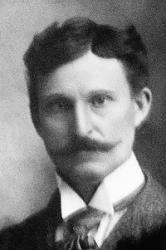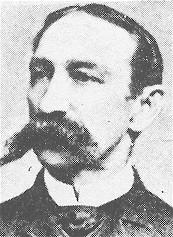Planning worship?
Check out our sister site, ZeteoSearch.org,
for 20+ additional resources related to your search.
- |
User Links
Person Results
‹ Return to hymnal




Export as CSV
Howard E. Smith

1863 - 1918 Hymnal Number: 7 Composer of "[We're a youthful Christian band]" in Sunday School Anthem and Chorus Book
Howard E. Smith
H. P. Danks

1834 - 1903 Hymnal Number: 252 Composer of "[Forward! be our watchword]" in Sunday School Anthem and Chorus Book
H. P. Danks
A. Cleveland Coxe

1818 - 1896 Person Name: Arthur C. Coxe Hymnal Number: 96 Author of "The Heavenly Visitor" in Sunday School Anthem and Chorus Book Coxe, Arthur Cleveland, D.D. LL.D. One of the most distinguished of American prelates, and son of an eminent Presbyterian minister, the Rev. Samuel H. Cox, D.D., was born at Mendham, New Jersey, May 10,1818. Graduating at the University of New York in 1838, and taking Holy Orders in 1841, he became Rector of St. John's, Hartford, Connecticut, in the following year. In 1851 he visited England, and on his return was elected Rector of Grace Church, Baltimore, 1854, and Calvary, New York, 1863. His consecration as Bishop of the Western Diocese of New York took place in 1865. His residence is at Buffalo. Bishop Coxe is the author of numerous works. His poetical works were mostly written in early life, and include Advent, 1837; Athanasion, &c, 1842; Christian Ballads, 1840 (Preface to the English edition, April, 1848); Hallowe'en and Other Poems, 1844; Saul, a Mystery, 1845, &c. Some of Bishop Coxe's hymns are found in the collections of every religious body in America, except the official collections of his own. This is accounted for by his too scrupulous modesty. As a member of the Hymnal Committee, in 1869-71, he refused to permit the insertion of his own lyrics. As he has not preserved memoranda, and has no precise recollection of dates, several dates here given are somewhat uncertain.
1. Behold an Israelite indeed. St. Bartholomew. First appeared in "Poems," published with his Christian Ballads, 1840, and found in an altered form in the People's H. and the Hymnary.
2. Body of Jesus, 0 sweet Food. Holy Communion. Written at St. James's College, Maryland (since broken up by the Civil War), Ascension Day, 1858. It was first printed for private use, and then published in the Cantate Domino, Boston, 1859, No. 53, and again in other American collections. It is also in Schaff’s Christ in Song, 1869, and in The Churchman's Altar Manual, 2nd ed., 1883.
3. Breath of the Lord, 0 Spirit blest.Whitsuntide. Bishop Coxe considers this more worthy of being called a hymn than anything else from his pen. It was written long before it appeared in the New York Independent, Whitsuntide, 1878. It is in the Schaff-Gilman Library of Religious Poetry, 1881, and Brooke's Churchman's Manual of Private and Family Devotion, 1883.
4. Christ is arisen. Easter. This is suggested by, and partly translated from, the famous Easter Chorus in Goethe's Faust, "Christ ist erstanden" (see Goethe), and appeared in Hallowe'en, 1844.
5. He who for Christ hath left behind. St. Matthew. From his Christian Ballads, &c, 1840.
6. In the silent midnight watches. Christ knocking. From his Athanasion, &c, 1842; an impressive moral poem rather than a hymn on Christ knocking at the door, extensively used in America, and sometimes in England. Original text, Schaff's Christ in Song, 1869.
7. Lord, when Thou didst come from heaven. A hymn for Epiphany, on behalf of Western Missions, appeared among the "Lays "appended to Hallowe'en, 1844, and again in later editions of the Christian Ballad. It is sometimes abbreviated, as in Lyra Sac. Amer., " Westward, Lord, the world alluring."
8. Now pray we for our country. National Hymn. A stanza from Chronicles, or meditations on events in the history of England, called up by visiting her abbeys and cathedrals, and appeared in Christian Ballads, 1840. Originally it began, "Now pray we for our mother," and, with the succeeding stanza, was a call upon Americans to pray for their mother country. It is adopted by Dr. Martineau in his Hys., 1873.
9. 0 walk with God, and thou shalt find. Holiness. Appeared in his Hallowe’en, &c, 1844, and is found in Lyra Sac. Amer.
10. 0 where are kings and empires now! Church of God. The 6th stanza of his ballad "Chelsea," which appeared in the Churchman, 1839, and again in his Christian Ballads, 1840.
11. Saviour, sprinkle many nations. Missions. “Begun on Good Friday, 1850, and completed 1851, in the grounds of Magdalen College, Oxford." 1st published. in Verses for 1851, in Commemoration of the third Jubilee of the Society for the Propagation of the Gospel, edited by the Rev. Ernest Hawkins, 1851. It was subsequently appended to the English edition of his Christian Ballads. It is regarded as Bishop Coxe's best piece, and to many minds it is the loveliest of missionary hymns. Its use in England is very extensive. It is not found in the American Episcopal hymnal for the reason given above.
12. Still as our day our strength shall be. Temptation. Appeared in his Hallowe'en, &c, 1844, and Lyra Sac. Amer.
13. Soldier, to the contest pressing. Christian Conflict. From his Hallowe'en, &c, 1844, and Lyra Sac. Amer. It was written in 1834.
14. There is a land like Eden fair. From Hallowe'en, &c, into a few collections.
15. We are living, we are dwelling. Christian Soldiers. An impressive moral poem rather than a hymn, but extensively used. It appeared in his Athanasion, &c, 1840, and Lyra &xc.
16. Who is this, with garments gory. Passiontide. From his “Lays" appended to Hallowe'en, 1844, and again in his Christian Ballads. It is found in the Child's Christian Year, 4th ed. N.D., the People's Hymns, and other collections. It is in 4 stanza of 8 1. The last stanza is sometimes given as a separate hymn:—"Hail, all hail, Thou Lord of Glory."
17. When o'er Judea's vales and hills. Written cir. 1840, and published in his Hallowe'en, &c, 1844, and again, with the author's final corrections, made in 1869, in Schaff's Christ in Song (1870 ed. p. 112). Also in the English edition of his Christian Ballads. From this "Hymn to the Redeemer," two shorter hymns have been com¬piled : (1) " How beauteous were the marks divine." This is in almost universal American and occasional English use. (2) "O who like Thee, so calm, so bright," in the Hymnary, 1872.
Bishop Coxe has also translated the Pange lingua gloriosi corporis (q. v.), and is the author of the beautiful Christmas Carol, "Carol, carol, Christians," given in his Christian Ballads, &c. [Rev. F. M. Bird]
-- John Julian, Dictionary of Hymnology (1907)
A. Cleveland Coxe
J. E. Hall
Hymnal Number: 168 Composer of "[Roses bring and lilies sweet]" in Sunday School Anthem and Chorus Book Hall, Jane E., of Battleborough, Vermont, has in I. D. Sankey's Sacred Songs and Solos, 18S1, under the initials "J. E. H.," (1) "The love that Jesus had for me" (Love of Jesus); (2) "We shall have a new name in that land" (The New Name). The music in Sankey to these hymns is also by the same person.
--John Julian, Dictionary of Hymnology, Appendix, Part II (1907)
J. E. Hall
Flora Kirkland
Hymnal Number: 142 Author of "Christmas-Tide" in Sunday School Anthem and Chorus Book Flora Kirkland was born in 1862 in Kentucky, before moving to Brooklyn, New York. After graduating from school she became a public school teacher for the seventh grade. She was a member of Tompkins Avenue Congregational Church for which she wrote a number of hymns. She was very active in the Wallabout Bay Mission in that neighborhood of Brooklyn. Most of Wallabout Bay would be filled in to make way for the Brooklyn Navy Yard. She died 17 January 1911.
Brooklyn Standard Union, 16 January 1911
Flora Kirkland
Richard Torrey
Person Name: R. Torrey, Jr. Hymnal Number: 86 Author of "The Beautiful River" in Sunday School Anthem and Chorus Book
Richard Torrey
F. G. Burroughs
1856 - 1949 Hymnal Number: 74 Author of "Above the Clouds" in Sunday School Anthem and Chorus Book F. G. Burroughs was born in 1856 (nee Ophelia G. Browning) was the daughter of William Garretson Browning, a Methodist Episcopal minister, and Susan Rebecca Webb Browning. She married Thomas E. Burroughs in 1884. He died in 1904. She married Arthur Prince Adams, in 1905. He was a minister. Her poem, "Unanswered yet" which was written in 1879, was published in the The Christian Standard in 1880 with the name F. G. Browning. She also wrote under the name of Ophelia G. Adams and Mrs. T. E. Burroughs.
Dianne Shapiro from The Literary Digest, July 29, 1899., The Register, Pine Plains, NY, October 24, 1884, Alumni Record of Wesleyan University, Middleton, Conn. 1921
F. G. Burroughs
Mrs. Frank A. Breck
Person Name: Mrs. F. A. Breck Hymnal Number: 19 Author of "Wonderful Light of His Love" in Sunday School Anthem and Chorus Book See Breck, Carrie Ellis, 1855-1934
Mrs. Frank A. Breck
Harriet E. Jones

1823 - 1915 Hymnal Number: 28 Author of "Guiding Star and Beacon Light" in Sunday School Anthem and Chorus Book Harriet E. Rice Jones, 1823-1915
Born: April 18, 1823, Pompey Hollow, Onondaga County, New York.
Died: 1915, Binghamton, New York.
Buried: Oran Community Church Cemetery, Pompey, Onondaga County, New York.
Daughter of Eleazer Rice, Jones lived in Onondaga County, New York. Her girlhood was spent on a farm, receiving what education the country schools and one term at high school could provide. She was always fond of reading, and was a great singer, with a clear ringing voice. On July 7, 1844, she married a son of Rev. Zenas Jones; her husband died in 1879. Her song writing career began when her poetry came to the attention of Dr. M. J. Munger, who asked if she could write some Sunday school hymns for him. She went on to write for Daniel Towner, J. C. Ewing, the Fillmore brothers, and others.
--hymntime.com/tch
Harriet E. Jones
Charles Walker Ray
1832 - 1917 Person Name: C. W. Ray Hymnal Number: 9 Author of "An Open Bible for the World" in Sunday School Anthem and Chorus Book Rv Charles Walker Ray DD USA 1832-1917. Born at Otselic, NY, he became a Baptist minister. He was educated at Hamlton College, Clinton, NY. He earned his doctorate from Monongahela College, Jefferson, PA. That school closed in 1894. He pastored at North Stonington, CT, for a number of years. He also served at Plymouth, NY. He married Julia Tracy Sheffield, and they had a son, Arthur. He wrote a number of books and song books: “Grace Vernon Bussell, the heroine of western Australia” (1878); “Spicy breezes” (1883); “The day school crown” (1892); “The revival helper: a collection of songs for Christian work and worship” (1893); “Bright blossoms of song” (1895); “Zion’s delight” (1901); “The song of songs of the King and his bride-an interpretation” (1913); “The fallacies and vagaries of misinterpretation” (1914). He died at Philadelphia, PA.
John Perry
Charles Walker Ray


 My Starred Hymns
My Starred Hymns


